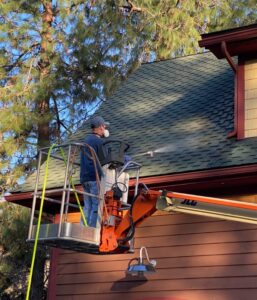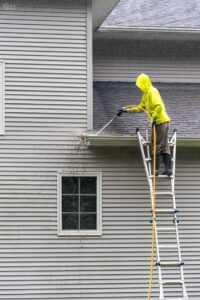Moss growth on a roof can be a serious issue if left untreated. While it may give a home a rustic or natural appearance, moss can cause structural damage and reduce the lifespan of roofing materials. Professional Roof Moss Removal Hillsboro Oregon services provide an effective and safe solution to keep roofs clean, functional, and long-lasting. Homeowners considering professional roof moss removal often wonder what to expect from the process. Understanding the steps involved, the benefits of hiring experts, and how to maintain a moss-free roof can help homeowners make informed decisions.
Understanding the Risks of Roof Moss
 Moss thrives in damp and shaded environments, making it a common problem for roofs in regions with high humidity, frequent rain, or dense tree cover. While moss may seem harmless at first, its presence can lead to significant damage over time. It retains moisture, which can cause roofing materials to deteriorate and weaken. Shingles or tiles may become loose, and wood structures beneath the roof can develop rot. In severe cases, moss buildup can lead to leaks, increasing the risk of costly interior water damage.
Moss thrives in damp and shaded environments, making it a common problem for roofs in regions with high humidity, frequent rain, or dense tree cover. While moss may seem harmless at first, its presence can lead to significant damage over time. It retains moisture, which can cause roofing materials to deteriorate and weaken. Shingles or tiles may become loose, and wood structures beneath the roof can develop rot. In severe cases, moss buildup can lead to leaks, increasing the risk of costly interior water damage.
Aside from structural issues, moss-covered roofs can negatively impact a home’s curb appeal and property value. A roof that appears neglected or covered in green patches may create an impression of poor maintenance. Additionally, insurance companies may view moss growth as a risk factor, potentially affecting coverage or claims related to roof damage.
The Professional Roof Moss Removal Process
Hiring professionals for roof moss removal ensures that the job is done safely and effectively. The process typically begins with an initial assessment, during which the roofing specialists evaluate the extent of moss growth, the condition of the roof, and any underlying damage that needs attention.
Once the assessment is complete, professionals use various methods to remove moss while preserving the integrity of the roofing materials. One common approach involves gentle brushing or scraping to detach moss without causing harm to shingles or tiles. High-pressure washing is generally avoided, as it can damage the roof’s surface and lead to water infiltration.
In many cases, specialized moss-killing treatments are applied to prevent regrowth. These treatments contain biodegradable and eco-friendly solutions that target moss while being safe for surrounding plants and landscaping. Some professionals may use zinc or copper strips, which create an environment that discourages moss from developing in the future.
After removing the moss and applying treatments, professionals conduct a thorough roof inspection to check for any signs of wear, leaks, or structural weaknesses. If repairs are needed, homeowners are advised on the best course of action to maintain the roof’s durability.
Why Choose Professional Moss Removal Over DIY Methods?
While some homeowners attempt to remove moss themselves, professional moss removal services offer several advantages. One of the primary benefits is safety. Climbing onto a roof without the proper equipment and experience can be dangerous. Professional roofers have the training, tools, and safety gear necessary to complete the job without risk of injury.
Another key benefit is the effectiveness of professional treatments. DIY methods, such as using household cleaning solutions or scraping moss off by hand, may provide temporary relief but fail to prevent regrowth. Professional treatments are designed to address the root cause of moss growth, ensuring long-lasting results.
Additionally, professional roofers can identify potential roofing issues that might be overlooked in a DIY attempt. Early detection of damage can prevent costly repairs in the future, making professional moss removal a cost-effective investment.
Preventing Future Moss Growth
 Once moss is removed from the roof, preventive measures can help keep it from returning. Regular roof maintenance, such as routine inspections and gutter cleaning, plays a crucial role in preventing moss buildup. Ensuring that the roof has proper drainage and airflow reduces the moisture levels that moss thrives on.
Once moss is removed from the roof, preventive measures can help keep it from returning. Regular roof maintenance, such as routine inspections and gutter cleaning, plays a crucial role in preventing moss buildup. Ensuring that the roof has proper drainage and airflow reduces the moisture levels that moss thrives on.
Trimming overhanging tree branches can also minimize shade and allow more sunlight to reach the roof, making it less hospitable to moss. Some homeowners choose to install zinc or copper strips along the roof’s ridge, as these metals release ions that inhibit moss growth when it rains.
Using moss-resistant roofing materials during a roof replacement can be a long-term solution for homeowners in areas prone to moss issues. Certain shingles are designed with built-in resistance to algae and moss, reducing the need for frequent maintenance.
The Cost of Professional Roof Moss Removal
The cost of professional roof moss removal varies based on factors such as roof size, severity of moss buildup, accessibility, and location. On average, homeowners can expect to pay anywhere from a few hundred to a thousand dollars for professional moss removal services. While this may seem like a significant expense, the investment is worthwhile in protecting the roof from long-term damage and avoiding costly repairs.
Some roofing companies offer maintenance plans that include periodic moss treatment, ensuring that the roof remains moss-free year-round. These plans can be beneficial for homeowners in areas where moss growth is a recurring issue.